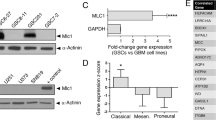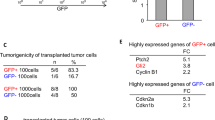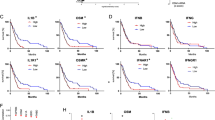Abstract
The GATA transcription factors consist of six family members, which bind to the consensus DNA-binding element, W- GATA-R, and are poorly characterized in the central nervous system (CNS). Using retroviral gene trapping on transgenic mouse glioma models, we identified GATA6 to be a novel tumor suppressor gene in glioblastoma multiforme. We now show GATA4, a family member of GATA6, to be expressed in the neurons and glia of normal murine and human embryonic and adult CNS. Silencing GATA4 in normal astrocytes did not alter their growth properties. In contrast, knockdown of Gata4 in p53 null non-transformed murine astrocytes induced transformation, with increased proliferation and resistance to chemotherapy or radiation-induced apoptosis. Furthermore, GATA4 expression was lost in a panel of human malignant astrocytoma cell lines. GATA4 overexpression in normal human and murine astrocytes resulted in a cell cycle block in G1 phase, with increased apoptosis. Mechanistically, GATA4 was a transcriptional inducer of the cyclin-dependent kinase inhibitor, p15INK4B, leading to the attenuation of cyclin D1. GATA4 expression was also induced by transforming growth factor-β, leading to the inhibition of astrocyte proliferation. Collectively, we show that GATA4 is expressed in the embryonic and adult CNS and acts as a negative regulator of astrocyte proliferation and growth.
This is a preview of subscription content, access via your institution
Access options
Subscribe to this journal
Receive 50 print issues and online access
$259.00 per year
only $5.18 per issue
Buy this article
- Purchase on Springer Link
- Instant access to full article PDF
Prices may be subject to local taxes which are calculated during checkout








Similar content being viewed by others
Abbreviations
- CNS:
-
central nervous system
- IHC:
-
immunohistochemistry
- NHA:
-
normal human astrocytes
- NMA:
-
normal murine astrocytes
- IF:
-
immunofluoresence cytochemistry
- GBM:
-
glioblastoma multiforme
References
Afouda BA, Ciau-Uitz A, Patient R . (2005). GATA4, 5 and 6 mediate TGFbeta maintenance of endodermal gene expression in Xenopus embryos. Development 132: 763–774.
Anttonen M, Parviainen H, Kyronlahti A, Bielinska M, Wilson DB, Ritvos O et al. (2006). GATA-4 is a granulosa cell factor employed in inhibin-alpha activation by the TGF-beta pathway. J Mol Endocrinol 36: 557–568.
Belaguli NS, Zhang M, Rigi M, Aftab M, Berger DH . (2007). Cooperation between GATA4 and TGF-beta signaling regulates intestinal epithelial gene expression. Am J Physiol Gastrointest Liver Physiol 292: G1520–G1533.
Bogler O, Nagane M, Gillis J, Huang HJ, Cavenee WK . (1999). Malignant transformation of p53-deficient astrocytes is modulated by environmental cues in vitro. Cell Growth Differ 10: 73–86.
Cantor AB, Orkin SH . (2002). Transcriptional regulation of erythropoiesis: an affair involving multiple partners. Oncogene 21: 3368–3376.
Capo-chichi CD, Roland IH, Vanderveer L, Bao R, Yamagata T, Hirai H et al. (2003). Anomalous expression of epithelial differentiation-determining GATA factors in ovarian tumorigenesis. Cancer Res 63: 4967–4977.
Caslini C, Capo-chichi CD, Roland IH, Nicolas E, Yeung AT, Xu XX . (2006). Histone modifications silence the GATA transcription factor genes in ovarian cancer. Oncogene 25: 5446–5461.
Garg V, Kathiriya IS, Barnes R, Schluterman MK, King IN, Butler CA et al. (2003). GATA4 mutations cause human congenital heart defects and reveal an interaction with TBX5. Nature 424: 443–447.
Guo M, Akiyama Y, House MG, Hooker CM, Heath E, Gabrielson E et al. (2004). Hypermethylation of the GATA genes in lung cancer. Clin Cancer Res 10: 7917–7924.
Guo M, House MG, Akiyama Y, Qi Y, Capagna D, Harmon J et al. (2006). Hypermethylation of the GATA gene family in esophageal cancer. Int J Cancer 119: 2078–2083.
Hannon GJ, Beach D . (1994). p15INK4B is a potential effector of TGF-beta-induced cell cycle arrest. Nature 371: 257–261.
Kamnasaran D, Guha A . (2005). Expression of GATA6 in the human and mouse central nervous system. Brain Res Dev Brain Res 160: 90–95.
Kamnasaran D, Qian B, Hawkins C, Stanford WL, Guha A . (2007). GATA6 is an astrocytoma tumor suppressor gene identified by gene trapping of mouse glioma model. Proc Natl Acad Sci USA 104: 8053–8058.
Kobayashi S, Lackey T, Huang Y, Bisping E, Pu WT, Boxer LM et al. (2006). Transcription factor gata4 regulates cardiac BCL2 gene expression in vitro and in vivo. FASEB J 20: 800–802.
Koutsourakis M, Langeveld A, Patient R, Beddington R, Grosveld F . (1999). The transcription factor GATA6 is essential for early extraembryonic development. Development 126: 723–732.
Kuo CT, Morrisey EE, Anandappa R, Sigrist K, Lu MM, Parmacek MS et al. (1997). GATA4 transcription factor is required for ventral morphogenesis and heart tube formation. Genes Dev 11: 1048–1060.
Lawson MA, Buhain AR, Jovenal JC, Mellon PL . (1998). Multiple factors interacting at the GATA sites of the gonadotropin-releasing hormone neuron-specific enhancer regulate gene expression. Mol Endocrinol 12: 364–377.
Lawson MA, Mellon PL . (1998). Expression of GATA-4 in migrating gonadotropin-releasing neurons of the developing mouse. Mol Cell Endocrinol 140: 157–161.
Lowry JA, Atchley WR . (2000). Molecular evolution of the GATA family of transcription factors: conservation within the DNA-binding domain. J Mol Evol 50: 103–115.
Luo Y, Fischer FR, Hancock WW, Dorf ME . (2000). Macrophage inflammatory protein-2 and KC induce chemokine production by mouse astrocytes. J Immunol 165: 4015–4023.
Morrisey EE, Tang Z, Sigrist K, Lu MM, Jiang F, Ip HS et al. (1998). GATA6 regulates HNF4 and is required for differentiation of visceral endoderm in the mouse embryo. Genes Dev 12: 3579–3590.
Patient RK, McGhee JD . (2002). The GATA family (vertebrates and invertebrates). Curr Opin Genet Dev 12: 416–422.
Perlman H, Suzuki E, Simonson M, Smith RC, Walsh K . (1998). GATA-6 induces p21(Cip1) expression and G1 cell cycle arrest. J Biol Chem 273: 13713–13718.
Quelle DE, Ashmun RA, Hannon GJ, Rehberger PA, Trono D, Richter KH et al. (1995). Cloning and characterization of murine p16INK4a and p15INK4b genes. Oncogene 11: 635–645.
Ray A, Ho M, Ma J, Parkes RK, Mainprize TG, Ueda S et al. (2004). A clinicobiological model predicting survival in medulloblastoma. Clin Cancer Res 10: 7613–7620.
Reamon-Buettner SM, Cho SH, Borlak J . (2007). Mutations in the 3′-untranslated region of GATA4 as molecular hotspots for congenital heart disease (CHD). BMC Med Genet 8: 38.
Reilly KM, Loisel DA, Bronson RT, McLaughlin ME, Jacks T . (2000). Nf1;Trp53 mutant mice develop glioblastoma with evidence of strain-specific effects. Nat Genet 26: 109–113.
Rempe DA, Lelli KM, Vangeison G, Johnson RS, Federoff HJ . (2007). In cultured astrocytes, p53 and MDM2 do not alter hypoxia-inducible factor-1alpha function regardless of the presence of DNA damage. J Biol Chem 282: 16187–16201.
Rich JN, Zhang M, Datto MB, Bigner DD, Wang XF . (1999). Transforming growth factor-beta-mediated p15(INK4B) induction and growth inhibition in astrocytes is SMAD3-dependent and a pathway prominently altered in human glioma cell lines. J Biol Chem 274: 35053–35058.
Setogawa T, Shinozaki-Yabana S, Masuda T, Matsuura K, Akiyama T . (2006). The tumor suppressor LKB1 induces p21 expression in collaboration with LMO4, GATA-6, and Ldb1. Biochem Biophys Res Commun 343: 1186–1190.
Shang Y, Myers M, Brown M . (2002). Formation of the androgen receptor transcription complex. Mol Cell 9: 601–610.
Sonoda Y, Ozawa T, Hirose Y, Aldape KD, McMahon M, Berger MS et al. (2001). Formation of intracranial tumors by genetically modified human astrocytes defines four pathways critical in the development of human anaplastic astrocytoma. Cancer Res 61: 4956–4960.
Temple S . (2001). The development of neural stem cells. Nature 414: 112–117.
Wada H, Hasegawa K, Morimoto T, Kakita T, Yanazume T, Abe M et al. (2002). Calcineurin-GATA-6 pathway is involved in smooth muscle-specific transcription. J Cell Biol 156: 983–991.
Acknowledgements
SA was supported by a RESTRACOMP studentship award from the Hospital for Sick Children and an Ontario Institute of Cancer Research award. Thanks to Dr Deepak Kamnasaran for technical advice and Jing Ma for technical assistance on IHC. AG was funded for this study by the National Cancer Institute of Canada, Brain Tumor Society and National Brain Tumor Foundation.
Author information
Authors and Affiliations
Corresponding author
Additional information
Supplementary Information accompanies the paper on the Oncogene website (http://www.nature.com/onc)
Rights and permissions
About this article
Cite this article
Agnihotri, S., Wolf, A., Picard, D. et al. GATA4 is a regulator of astrocyte cell proliferation and apoptosis in the human and murine central nervous system. Oncogene 28, 3033–3046 (2009). https://doi.org/10.1038/onc.2009.159
Received:
Revised:
Accepted:
Published:
Issue Date:
DOI: https://doi.org/10.1038/onc.2009.159
Keywords
This article is cited by
-
Simiate and the focal adhesion kinase FAK1 cooperate in the regulation of dendritogenesis
Scientific Reports (2022)
-
GATA4 Is a Transcriptional Regulator of SOX2 in Japanese Flounder (Paralichthys olivaceus)
Journal of Ocean University of China (2022)
-
p15INK4b regulates cell cycle signaling in hippocampal astrocytes of aged rats
Aging Clinical and Experimental Research (2016)
-
RNAi in murine hepatocytes: the agony of choice—a study of the influence of lipid-based transfection reagents on hepatocyte metabolism
Archives of Toxicology (2015)



